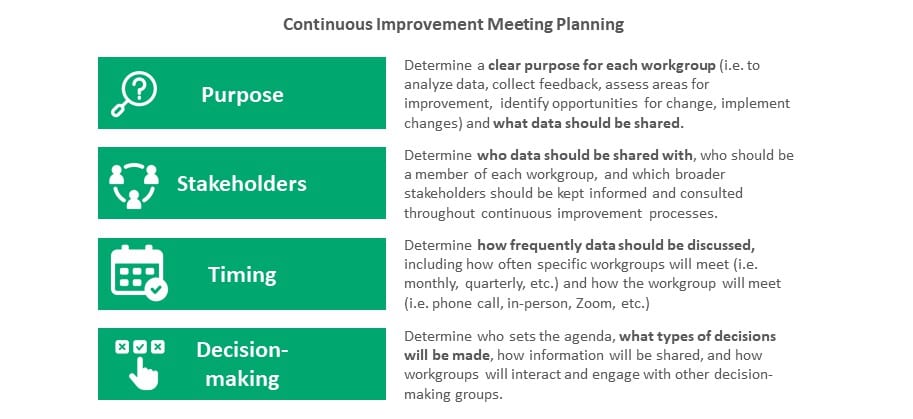Principles for Continuous Improvement: Collaborative, Data-Driven Conversations
This is the second post in our data-driven continuous improvement blog series. To read the first blog on best practices for creating a data dashboard, click here. In this post, we’ll share three tips for continuous improvement conversations.
The data is ready. The graphs are finalized. The trends are highlighted. Your shiny new report detailing workforce credentialing and job placement program outcomes over the last 6 months is ready to be released. You are eager to send it to training and coaching service providers. As public sector data enthusiasts, we, too, would be hovering over the send button on our email. And, here’s what we would do before sending in order to ensure that the data is used to build equitable relationships with providers and partners, continuously improve programs and policies, and ultimately lead to better participant outcomes.
Invest in building collaborative relationships with providers and partners
Whenever a government funder communicates with a provider or community partner, there is an inherent power dynamic that benefits the funder. Third Sector has worked with many government contract managers who share that they know that their emails and visits make providers nervous. This signals a relationship built on fear and distrust. These top-down, compliance-driven relationships are often based on a history of using data and conversations as “gotcha” moments to “catch” providers doing something wrong, as opposed to opportunities to elevate providers’ local expertise and lived experiences to inform the path forward. These relationships take time to heal and require real change in order to build trust and create equity. Sharing a new and improved data dashboard, even if providers gave input into their structure, will not fix the relationship by itself. However, there are concrete steps that government funders can take in sharing this data that works towards improved collaboration.
First, commit to transparency as a means of upholding equity between funders and providers in how the data is analyzed, interpreted, and used. Align on what data will be shared, with what frequency, and why. Ensure that the data is clearly labeled and shared data definitions are documented and commonly understood. Next, build capacity for data interpretation and use. Information is not transparent if it is coded or cannot be commonly understood. In some cases, governments offer training for providers to learn how to interpret the data they are receiving. Lastly, repeat the purpose and guiding principles of sharing this data frequently and in different mediums. Common phrases we’ve seen used include: “this is a learning year”; “quantitative data helps us focus the conversion, but does not tell the full story”; and “data, combined with local expertise, will inform our next steps.”
Plan and hold Continuous Improvement meetings that foster data discussion
After the data has been shared and the expectations for a “different kind” of funder-provider relationship have been established, regularly scheduled Continuous Improvement meetings should be set up in order to realize the goals of this more equitable relationship. In some cases, continuous improvement conversations can be built into existing meetings, such as statewide provider “learning labs” or provider site visits. For each continuous improvement touchpoint, it’s important to align on a basic structure to ensure that expectations are aligned. Third Sector recommends using this simple framework for planning for a continuous improvement meeting:

Continuous improvement meetings should be spaces of mutual curiosity and exploration. While they may start with the identification of a trend in the quantitative data, the expectation is that qualitative data and program anecdotes will build a clearer picture of the drivers behind the trend and inform potential changes. For example, the trend identified may be that median earnings post-job placement have declined in recent months. Providers can illuminate why their program participants are experiencing that trend. Potential reasons could be the loss of an employer partner who paid higher wages, the seasonality of the labor market and the expected annual drop in wages over the summer when participants take seasonal work, or their increased focus on outreach to a population with less prior work experience. As this example illustrates, establishing the “why” behind the data trend is critical for informing any potential decisions or changes to be made.
Follow-through on the promise to act on the data
Ultimately, the funder-provider relationship will be sustained and continuous improvement of program outcomes will be realized only if action is taken and change occurs as a result of the Continuous Improvement meeting. And the expectation cannot always be that the follow-up action is that the provider must “do more” and “do better” without additional support. In the case of the example meeting that discusses the decline in median earnings post-job placement, there are a number of actions that the government funder can take in pursuit of improved outcomes, depending on the root cause identified. The funder could provide:
- Additional data or connections to support the provider’s identification and partnership with additional employers
- Flexibility in policies or dollars to ensure that the provider can support not only the placement in seasonal work, but also then the transition into full-time roles
- Connections to additional services that have been shown to support the new population being served
As with any meeting, it is important to document and communicate commitments to carry out next steps and on what timeline and to carry out those actions. Then, future Continuous Improvement meetings can be used to see if those changes resulted in any movement in the data and to identify if further or different action is required.
To be successful, continuous improvement processes require a shift in mental models. Before you hit send on your latest data report, stop and ask: How is this building a more equitable relationship with providers? How am I communicating that this data is just the start of a conversation and not the final word? Is my agency committed to acting based on what we learn in order to support providers and participants to achieve better outcomes? Once you can answer those questions, you are well on your way to a collaborative, continuous improvement approach.

